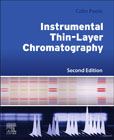
Instrumental Thin-Layer Chromatography, Second Edition offers a comprehensive source of authoritative information on all aspects of instrumental thin-layer chromatography. The use of short, topic-focused chapters facilitates identifying information of immediate interest for familiar or emerging uses of thin-layer chromatography. The book gives those working in both academia and industry the opportunity to learn, refresh, or deepen their understanding of fundamental and instrumental aspects of thin-layer chromatography, as well as the tools to interpret and manage chromatographic data. The book serves as a practical consolidated guide to the selection of separation conditions and the use of auxiliary techniques. This fully updated new edition restores the contemporary character of the book for those involved in advancing the technology, analyzing data produced, or applying the technique to new application areas. Some chapters have been consolidated to make room for topics not covered in the first edition, reflecting general changes in the field of thin-layer chromatography, especially in effects-directed detection, convenient interfaces for advanced spectroscopic detection, and greater automation possibilities. This book is a valuable reference for anyone who needs to acquire fundamental and practical information to facilitate progress in research and management functions utilizing information acquired by thin-layer chromatography. Features individual chapters written by recognized authoritative and visionary experts in the field Provides an overview and focused treatment of a single topic Provides tables and diagrams with commonly used data to facilitate practical work, comparison of results, and decision-making Places modern developments in the research literature into a general context not always apparent to inexperienced users of the technique Offers comprehensive updates to all chapters Includes new chapters on instrument platforms, effects-directed detection, data analysis tools, small-scale and microfluidic planar separation systems, and applications to the separation of amino acids and peptides, the analysis of saccharides and lipids, and forensic analysis INDICE: Section 1: Fundamentals and Practice of Thin-Layer Chromatography 1. Core Concepts and Milestones in Thin-Layer Chromatography 2. Stationary Phases for Thin-Layer Chromatography 3. Solvent Selection and Method Development 4. Automated Multiple Development 5. Development by Forced-Flow and Pressurized Planar Electrochromatography 6. Instrument Platforms for Thin-Layer Chromatography 7. Theory and Instrumentation for In Situ Detection 8. Advanced Spectroscopic Detectors for Identification and Quantification: Infrared, Raman and Nuclear Magnetic Resonance 9. Advances Spectrometric Detectors for Identification and Quantification: Mass Spectrometry 10. Staining and Derivatization Techniques for Detection 11. Effects-Directed Detection: Biological Assays 12. Effects-Directed Detection: Enzymatic Assays 13. Validation of Thin-Layer Chromatographic Methods 14. Data Analysis Tools in Thin-Layer Chromatography 15. Small-scale and Microfluidic Planar Separation Systems Section 2: Applications of Thin-Layer Chromatography 16. Applications of Thin-Layer Chromatography to the Separation of Amino Acids and Peptides 17. Applications of Thin-Layer Chromatography to the Analysis of Saccharides 18. Applications of Thin-Layer Chromatography to the Analysis of Lipids 19. Applications of Thin-layer Chromatography in Food Analysis 20. Applications of Thin-Layer Chromatography in Environmental Analysis 21. Applications of Thin-Layer Chromatography in the Pharmaceutical Industry 22. Applications of Thin-layer Chromatography in Forensic Analysis 23. Applications of Thin-Layer Chromatography in the Quality Control of Botanicals 24. Applications of Thin-Layer Chromatography in the Quality Control of Dietary Supplements
- ISBN: 978-0-323-99970-0
- Editorial: Elsevier
- Encuadernacion: Rústica
- Páginas: 660
- Fecha Publicación: 20/01/2023
- Nº Volúmenes: 1
- Idioma: Inglés
